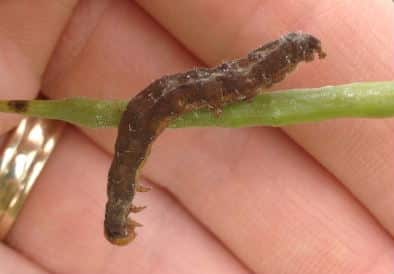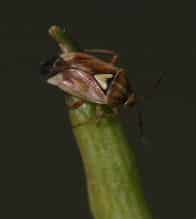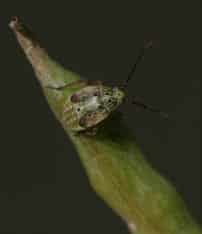In parts of central Alberta, lygus counts continue to exceed thresholds significantly (with counts as high as 450 lygus in 10 sweeps in some fields). In other areas, lygus numbers are just at or approaching threshold but the crop is very near to swathing. With these counts, growers are encouraged to resist the urge to simply spray and to be vigilant when scouting for lygus. Some insect species (eg. bertha armyworm) can decimate a crop if left uncontrolled, but it is unlikely lygus bug will cause a complete crop loss.
As pods mature and become leathery, lygus bugs are unable to pierce and feed and will move to less mature pods (ie. side branches). Examine the architecture of the plants, and quantify if these less mature areas are where the bulk of the yield is located. Consider also the growing conditions. Is there sufficient moisture to fill these later stages? If so, then it may be economical to spray late in the season (7 to 10 days before swathing). Once the crop is swathed, lygus can no longer feed and will move onto other more desirable hosts.
Click here for more information on lygus (ie. sweeping technique, effects of weather, economic thresholds, etc.).
Bertha armyworm spraying is continuing in parts of Saskatchewan. Unlike lygus, if left uncontrolled bertha armyworm can cause significant yield loss because of the larva’s chewing mouthparts. Canola is susceptible even if the pods are beginning to ripen. The shortest insecticide pre-harvest interval (PHI) is 7 days, so growers with canola that is a week or more away from being ready to swath are encouraged to get out and scout to determine if spraying for bertha armyworm will be necessary. If it will, choose a product with an appropriate PHI and ensure spraying is completed at least that many days before cutting (swathing or straight cutting). Once the crop is within a week of cutting it is too late to spray because no registered products with a short enough PHI are available, and any application will put your crop at risk for residues that exceed maximum residue limits. Click here for more information on bertha armyworm (scouting video, economic thresholds).
Click here to review last week’s information bertha armyworm, lygus bug, and fall flea beetle populations.

Mother Nature is believed to be helping control bertha armyworm in a number of regions this year. Numerous larva have been found parasitized by the nuclear polyhedrosis virus and by a fungal pathogen. Larva succumbed to the virus are found still attached to the plant and look as if they have melted onto the plant. Pathogens can at times be very effective at reducing bertha armyworm populations. Levels will vary but infection rates by the virus as high as 95% of the population have been recorded (Erlandson, 1990). Some scouts in fields in Manitoba are finding parasitism rates as high as 30%.

